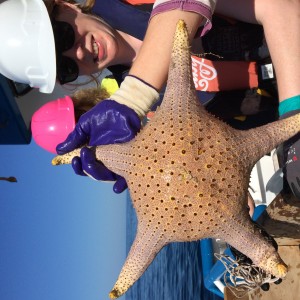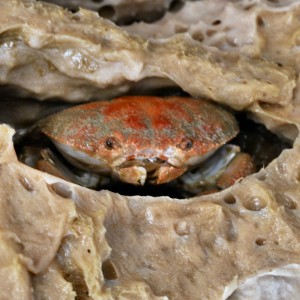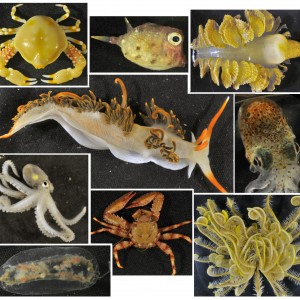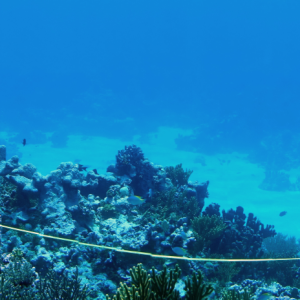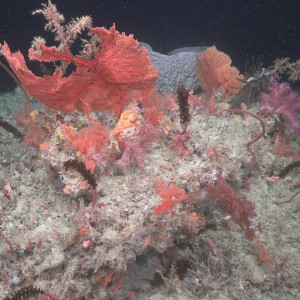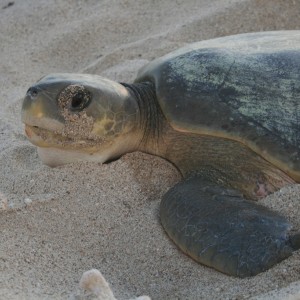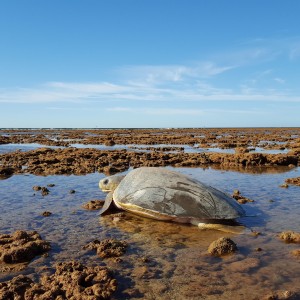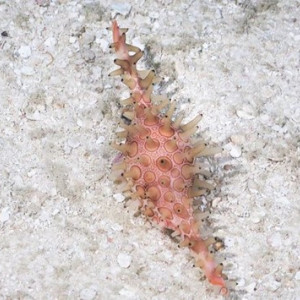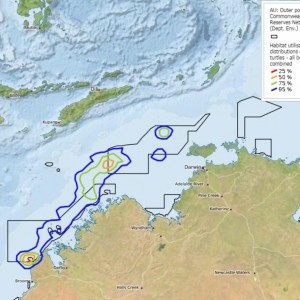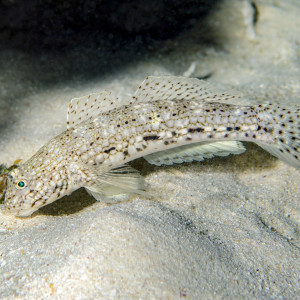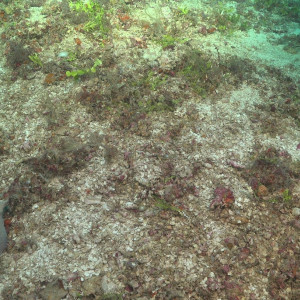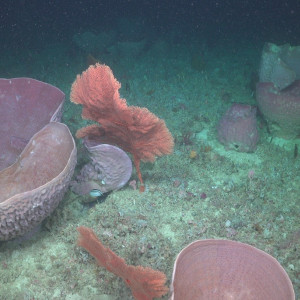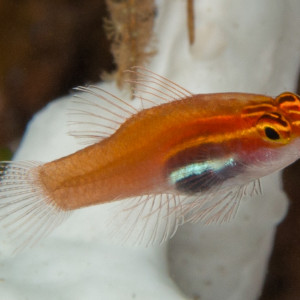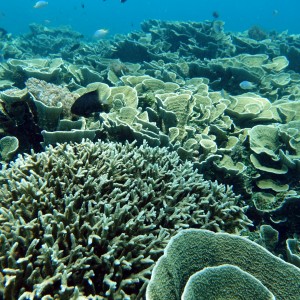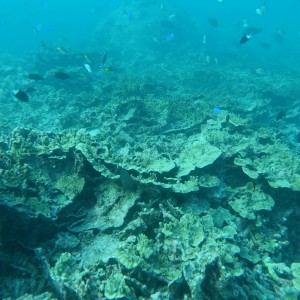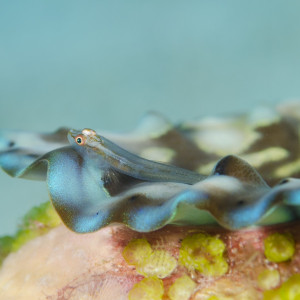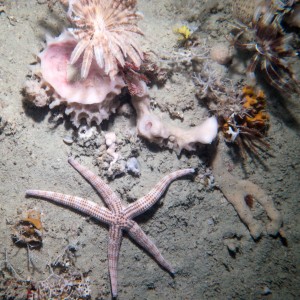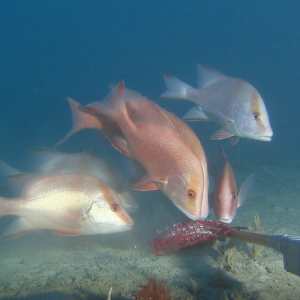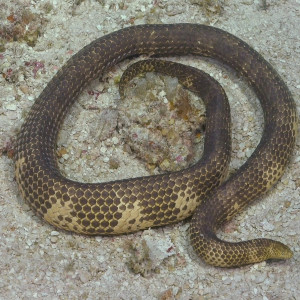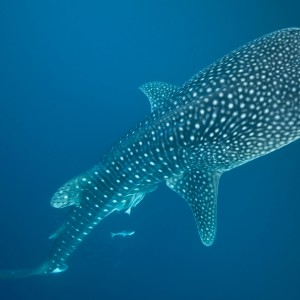This image was taken as part of a photo transect on the reef at Cartier Island.
Reefs are incredibly important habitats. They provide a hard surface to which benthic organisms such as corals, kelps and sponges can attach, and once these organisms establish they provide complex 3D structures which can alter the environment by influencing factors such as water flow and the amount of light reaching the seafloor. A healthy reef ecosystem can contain thousands of different species of fish and invertebrates which are well adapted to these unique conditions, and use these habitats for shelter, foraging and recruitment grounds. This crab in the Kimberley Marine Park has made it's home inside a sponge, where it was found hiding with a host of juveniles.
These are examples of different organisms that were sampled during a Western Australian Marine Science Institution (WAMSI) trip to Lynher Bank, approximately 120 nauticle miles north of Broome. This area is an important foraging ground for the Flatback turtles, and the trip focused on collecting samples from the seaflooor and water column to determine what food is available to these protected species. Clockwise from the top left is a crab, fish, seapen, cuttlefish, feather star, crab, jellyfish, octopus and nudibranch. The chemical composition of these samples, and many others, will be tested and compared to that found in flatback turtle tissue to determine if the turtles are eating these organisms.
 by CSIRO
by CSIROMonitoring sites were surveyed along permanent transect lines, photographed at 1 metre intervals
 by AIMS
by AIMSDiverse benthic communities were observed in the mesophotic zone at Ashmore Reef, including a mix of colourful sponges, gorgonians and soft corals
 by Schmidt Ocean Institute / AIMS
by Schmidt Ocean Institute / AIMSThe great spotted cowrie – discovered for the first time in Western Australia during the Ashmore Reef Mesophotic voyage
 by Schmidt Ocean Institute / AIMS
by Schmidt Ocean Institute / AIMSThis map shows the home ranges of the 11 tracked flatback turtles during the inter-nesting period in waters off the Kimberley coast in northwest Australia. The coloured contours represent the 25, 50, 75 and 95 % habitat utilisation distributions of the turtles, and the Australian Marine Park boundaries are shown in black. For more information on about this image see Thums et al. 2017.
Istigobius decoratus, known as the Decorated Sandgoby is found on sand patches near reefs.
 by Ian Shaw
by Ian ShawHalimeda beds in the shallow mesophotic at Ashmore Reef. These habitats are home to a diverse array of marine species and contribute greatly to the diversity of the reef.
 by Schmidt Ocean Institute / AIMS
by Schmidt Ocean Institute / AIMSSponge communities in the mesophotic zone at Ashmore Reef Marine Park
 by Schmidt Ocean Institute / AIMS
by Schmidt Ocean Institute / AIMSA wide diversity of tiny cryptic fishes are associated with lagoon bommies in the Coral Sea and at Ashmore Reef (NW Network), including the Neon Eviota (Eviota atriventris).
 by Rick Stuart-Smith
by Rick Stuart-SmithThe northern sites at Ashmore had some of the highest coral cover in 2016 and were dominated by tabulate, branching and foliose corals.
 by AIMS
by AIMSCommunities at the northern sites at Ashmore Reef were worst affected by bleaching in 2016/17. Recently dead foliose corals were observed at this northern site in 2017.
 by AIMS
by AIMSPleurosicya mossambica also known as the toothy goby or the Mozambique ghost goby is found on many substrates, including corals, sponges, giant clams and seaweeds, and can vary colour according to the substrate.
 by Ian Shaw
by Ian ShawResearchers captured stunning vision and measurements of fish species at the bottom of Ningaloo Reef in Ningaloo Marine Park using a stereo pair of baited remote underwater video systems, also known as ‘BRUVs’.
The short-nosed sea snake, thought to be extinct in the Ashmore Reef region, was re-discovered during the voyage
 by Schmidt Ocean Institute / AIMS
by Schmidt Ocean Institute / AIMSThis whale shark was photographed in the Ningaloo Marine Park off Western Australia. Whale sharks are the worlds biggest fish. The name whale shark arose because they are as big as a whale (recorded up to 18 metres) and also filter feed much like many whales. However, whale sharks breath via gills, and have cartilage instead of bone, which makes them a true shark. The Ningaloo Marine Park is a well known for the whale sharks that visit the region from the months of March to July each year. There is still a lot to learn about whalesharks and where they go when they are not at Ningaloo.
 by Wayne Osborne
by Wayne Osborne
